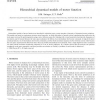Free Online Productivity Tools
i2Speak
i2Symbol
i2OCR
iTex2Img
iWeb2Print
iWeb2Shot
i2Type
iPdf2Split
iPdf2Merge
i2Bopomofo
i2Arabic
i2Style
i2Image
i2PDF
iLatex2Rtf
Sci2ools
IJON
2007
2007
Hierarchical dynamical models of motor function
Hierarchical models of motor function are described in which the motor system encodes a hierarchy of dynamical motor primitives. The models are based on continuous attractor neural networks, in which the packet of neural activity representing the position (in the state space) is moved by path integration using a motor efference copy after training with a traced associative learning rule. Sequences of movements can be learned because the state space modulates the effects of an intermediate level motor command. A high-level motor command selects a set of intermediate level motor commands, and the whole movement sequence evolves with the correct order because the state space representation effectively selects the next possible intermediate level command. Thus a single high-level motor command can select whole movement trajectories composed of a set of motor primitives. It is further shown that the network can perform completely novel motor sequences, and thus provides one solution to Las...
| Added | 15 Dec 2010 |
| Updated | 15 Dec 2010 |
| Type | Journal |
| Year | 2007 |
| Where | IJON |
| Authors | Simon M. Stringer, Edmund T. Rolls |
Comments (0)

